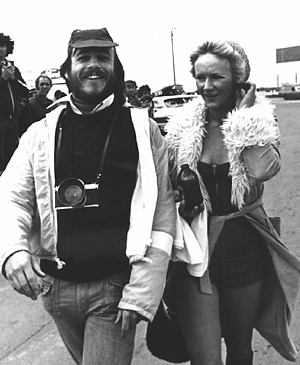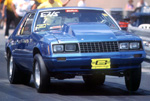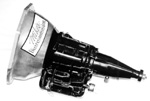|
|
|
||||
|
|
|
||||
Just Watch The Crocs
How do you get a race car down a race track? The answer is obviously as fast as possible, but the problem for drag racing - the quickest and fastest of motorsports - has always been what do you do with them afterwards. Hmmmm! One of the principal considerations when it comes to speed in drag racing in recent years has been the space required to stop cars doing 300-plus mph, especially if something goes wrong. Thirty years ago the speeds were nothing like that, and in fact, were seen to be awesome at the then magical "barrier" of 200 mph, but the same problems applied, especially in Australia where the sport was still very young and experience with any sort of car which could go that fast was mighty limited. Those problems were exacerbated at regional centres, like that in Townsville, in far the north of the state of Queensland, especially where they were building new race tracks, and of course there were limits on budgets and things weren't pushed to the limit of possibilities. Up in Townsville - cos that's where we're talking about - they built this lovely new drag strip in 1969 at a time when it seemed that everyone wanted to have a nice new drag strip in their backyard. For the time it was a classy arrangement, except that it was a bit short in the braking area, like many of its contemporaries. Savanna, as it was named, was constructed on a marshy plain to the south of the north Queensland city, amongst patches of mangrove trees, winding salt marshes and creeks. Right from the start Savanna began to attract some top line race teams, including imports such as Leland Kolb and his fueller, the Vic Wilson/Bill Fredericks "Courage of Australia" rocket car, E.J. "Michigan Madman" Potter with his V8 bike, as well as the top in Australian drag racing machinery. After Kolb finished his tour in 1969 - having featured at the opening meeting of the strip - he sold the ex-Beebe and Mulligan front engined fueller to Keith Williams, the owner of the still relatively new drag strip at Surfers Paradise, in the south of Queensland, who hired ex-speedway racer Peter Dykes to drive the car. Dykes was a fearless driver with a great record on the dirt ovals, with both bikes and speedcars, and had had a limited amount of experience driving for Melbourne Top Fuel owner Graham Withers. Amongst Dykes' first contracted appearances was to take this top line ex-US fueler to Savanna for a night race meeting. Like most tracks just getting into the notion of racing at night the lighting in the braking area wasn't great. The rationale was that since there were few spectators interested in the cars in the braking area you didn't have to put much in the way of lights down there. The fact that the drivers desired to see what was going on seemed neither here nor there. Plunging into near inky blackness at 200 mph while strapped into a car that, by today's standards, was pretty light on with brakes and safety features, took a big heart, but hey, everyone was young and immortal. On this night Dykes' big heart was tested to the max. On one run the chute failed to open, a not uncommon problem, even today, but certainly more common back then. With the marginal braking area at Savanna this was a real tester. Hauling on the brake handle for all he was worth Dykes' ride zeroed in on the rapidly diminishing end of the race track. Now, Savanna had been built, as stated, on this marshy plain, and at the bottom end it extended into a stand of mangrove trees. Into these the front engined fueller plunged at a great rate of knots. The springy and flexible trees didn't break, they just laid down at an angle of about 45 degrees and up this ramp the speeding digger shot, and then took off. Unable to see all this, the track crew knew only that the car's chute hadn't appeared near the finish line as expected, and down they rushed to find the errant car, except when they got to the end of the braking area there was only a bunch of mangrove trees laying over at an angle, and no race car. There was a mad scramble for torches, and into the mangroves the brave rescuers plunged, keeping in mind that this was saltwater crocodile country, in the tropics, and who knew what you might step on in the dark. It took them some time - some reports indicate as much as half an hour - to find the dragster. What had happened was that in its silent flight through the air, after launching from the trees, the car did a slow barrel roll, with the weight of the engine hanging down beneath as it plunged back down towards the ground, a long way from its take-off point. It landed with a resounding crunch, upside down, still in mangroves, with large logs and broken trees jammed between the front of the roll cage and the back of the blower.
Dykes was hanging upside down in his straps, unable to get his hands up near his face mask to remove it and call for help, and with it firmly strapped over his head he couldn't be heard by the rescuers. They eventually found him, rolled the car over enough to get him out, and the car was retrieved from the bogs and put back to original trim. It didn't stop Dykes from driving, either this car or any other, and his driving career in drag racing continued into the late 70s, but as it's probably the only time that a drag racer has been potentially threatened by crocodiles there has never been a rule written requiring the carrying of firearms while racing in the tropics. But thankfully these days there are requirements for adequate lighting in the braking area. **************************************** If anyone has anything particularly worthwhile to say or ask about things here, drop me an email at dragster_oz@hotmail.com and I’ll see if I can answer you.
|
|
||||
|
|
Copyright 1999-2001, Drag Racing Online and Racing Net Source |
||||







